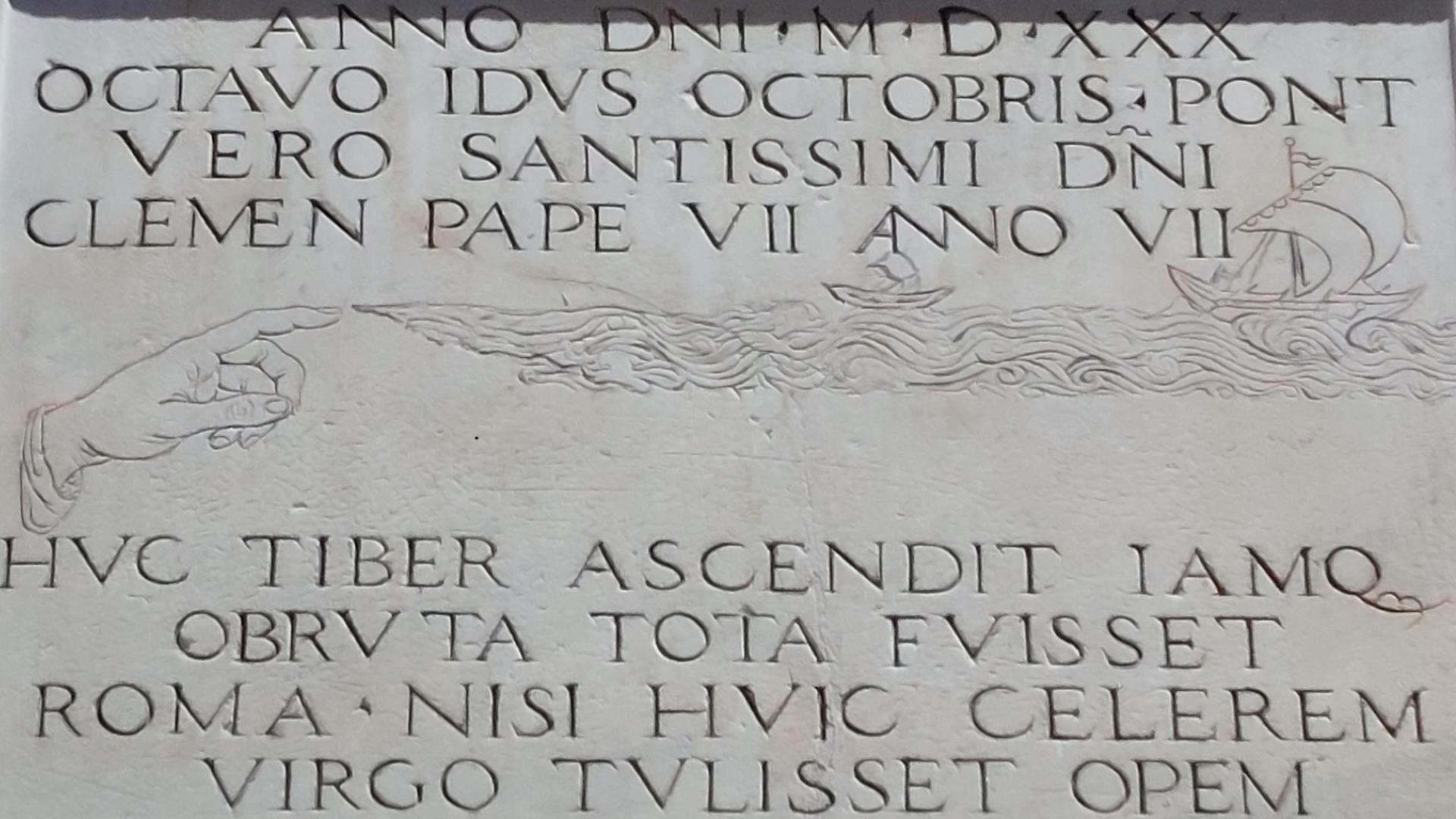You are here
news
Historic Shops of Excellence in Rome
A great wealth of knowledge and experience accumulated in the past
In Rome, even shops have a long history. Some of the commercial activities of the city center were recognized as a major part of the city’s heritage by the local institutions. They very often have authentic old decors and furniture or antique shop windows and signs having historical or artistic value.
Founded in 2008, the Association of Historical Stores of Excellence is a unique reality in Italy: combining tradition and innovation, it aims to meet future market challenges by leveraging on past knowledge and experience. To be associated, a business must have been run by the same family for at least 3 generations and for over 70 years. All companies represent an excellence in their sector and contribute to improve marketing of the city image and attract tourists.
Each business plays a key role in the qualification of the urban fabric and promotes traditional crafts at risk of dying out. “We have the privilege and the luck of working in the historic center of one of the most beautiful cities in the world”, explains Stefano Pizzolato, President of the Association. “It is important to understand that Rome is Italy’s business card and that a living, authentic and organized historical center, in addition to conveying beauty, can bring economic benefits to the rest of the city, including suburbs”.
The associated businesses are listed below.
CLOTHING AND ACCESSORIES
- Banchetti Sport - Via di Campomarzio n. 38 www.banchettisport.net
- Bertoletti 1882 - Via Vittoria n. 16 www.bertolettipelliccerie.it
- Caleffi Roma 1911 - Via In Aquiro n. 71 www.caleffiroma1911.com
- Davide Cenci - Via di Campo Marzio n. 1 www.davidecenci.com
- Sartoria Litrico - Via Michele Mercati 35 - www.sartorialitrico.it
- Zampieri 1949 - Viale Bruno Buozzi 21 - zampieri1949.com
SMOKING SHOPS
-
Fincato La Casa del Habano - Via della Colonna Antonina 34 - www.fincatolacasadelhabano.com
BAR, CAFES, ICE-CREAM PARLORS, CONFECTIONERIES
- Antico Caffè Greco - Via dei Condotti n. 86 - www.anticocaffegreco.eu
- Babingtons - Piazza di Spagna n. 23 - www.babingtons.com
- Caffè Ciampini - Piazza San Lorenzo in lucina n. 29 ciampini.com/
- Ciampini di Marco Ciampini - Piazza Trinità dei Monti snc ristoranteciampini.com/it
- Giolitti - Via degli Uffici del Vicario n. 45 www.giolitti.it
HOUSEHOLD LINENS, LINGERIE, UNDERWEAR
- Tebro - Via dei Prefetti n. 46 www.tebro.it
CARPENTRY AND BRICOLAGE
- Ditta Francesco Paolucci - Via di Montoro n. 5 www.falegnameriaromacentro.it
PENS AND LUXURY GIFTS
- Antica Cartotecnica - Piazza dei Caprettari n. 61 www.anticacartotecnica.it
- Stilo Fetti - Via degli Orfani n. 82 www.stilofetti.it
PHARMACIES
-
Antica Farmacia Reale 1672 - Via del Gambero 13a
CONFECTIONERIES, BAKERIES, FOOD AND BUTCHERS
- Forno pasticceria Angelo Colapicchioni - Via Tacito n. 76/78 www.colapicchioni.it
- Macelleria Angelo Feroci - Via della Maddalena n. 15 www.angeloferoci.it
WATCHES AND JEWELLERY
- Bedetti - Piazza San Sivestro n. 9-12 www.bedetti.it
TYPICAL ROMAN RESTAURANTS
- Ristorante Ai due ponti - Via Flaminia n. 858 - www.ristoranteaidueponti.com
- Bistrot Collegio - Piazza Capranica n. 99 collegioroma.com
- Trattoria Da Romolo alla Mole Adriana - Via delle Fosse di Castello n. 19 daromoloallamoleadriana.it
- Trattoria Giggetto al Portico D'Ottavia - Via del Portico d'Ottavia n. 21a/22 www.giggettoalportico.it
- Il vero Alfredo - Piazza Augusto Imperatore n. 30 www.ilveroalfredo.it
- Ristorante Massimo d'Azeglio - Via Cavour n. 16 www.romehoteldazeglio.it
TABLEWARE, SILVER, CRYSTAL
- Ditta Leone Limentani - Via del Portico d'Ottavia n. 47 www.limentani.com
Further information at: www.negozistoricieccellenza.it
Babingtons

 Condividi
Condividi
A Corner of England in the Heart of Rome
Forno Pasticceria Angelo Colapicchioni

 Condividi
Condividi
The Irresistible Charm of the Art of Baking
TEBRO Biancheria dal 1867

 Condividi
Condividi
Masters of Elegant Home Textiles and Nightwear
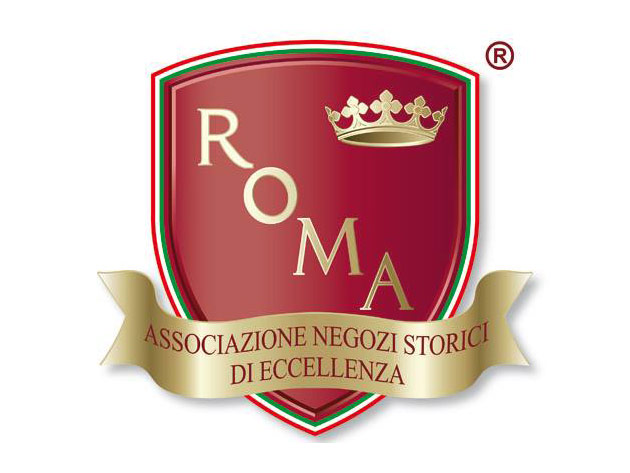
The Portico of Octavia
Location
The Roman Forum and the Palatine
Locations
Piazza Venezia
Location
Palazzo dello Sport
Location
Palazzo Mattei
Location
Church of San Benedetto in Piscinula
Location
Flood plaques
A bumpy millennial relationship
Rome’s history runs parallel to that of the river that flows through it, ever since the legendary founding of the city: it was the Tiber perhaps in flood, 28 centuries ago, that carried the basket of Romulus and Remus to the spot where they were found by the she-wolf, at the base of the Palatine Hill. But in the relationship between the Romans and their river, love was never the only feature. It provided a wide range of benefits, no doubts about it, but it was also capricious, irascible and vengeful like any true deity, and as such it could not fail to arouse a certain guarded distrust, even a holy terror. For the repeated floods, first of all, which for more than two thousand years caused sometimes immeasurable damage to the city, exacting a heavy toll of blood and bringing with it, along with the stagnant water, a trail of disease and pestilence.
Huc Tiber ascendit
That is, so far the Tiber has risen. When fear gives way to amazement, it is only natural to want to hand down to posterity the exceptional nature of an event, to rewrite the record book. And so, sometimes half-hidden on the walls of churches, in the courtyards of buildings and on street corners, walking in the lowest parts of the city we will come across a large number of old plaques, made of marble or stone, that tell us about the unpredictability of the waters and their violence. More than 120 plaques, most of them preserved, were hung up to the 1930 to commemorate the floods: the simplest ones show only the flood’s month and year while in the most elaborate ones the waters are represented by wavy lines, with a stylized little hand indicating the actual level of the flooding on the wall. The oldest stone record of a flood dates back to 1180 and is engraved on a marble column, now in the Museum of Rome in Palazzo Braschi. Also no longer in its original location is the plaque in Gothic characters currently under a small arch at one end of Arco dei Banchi, once walled on the façade of the church of St Celso e Giuliano, close to Ponte Sant’Angelo: it recalls the flood of November 1277, the year in which floods began to be indicated with reliable and historically verifiable data.
Historical floods
The first plaque that still correctly reports the level reached by flood waters refers to the November 1422 flood and is located on the façade of Santa Maria sopra Minerva. It is in good company because the church, located in one of the lowest areas of the city where the water reached considerable heights, also preserves the memory of the floods of the years 1495, 1530, 1598 and 1870. Between the 15th and 18th centuries, the most devastating one was probably the Christmas flood of 1598, when the floodwaters reached a level of 19.56 meters at Ripetta, a record unsurpassed, submerging the columns of the Pantheon by as much as six meters and causing thousands of deaths. Nine mills were destroyed by the Tiber’s current, which even dragged away the corpses in the tombs of Santa Maria dell’Anima and swallowed three of the six arches of the ancient pons Aemilius, known at the time as Ponte Senatorio and from that day on renamed Ponte Rotto, the Broken Bridge. The damages were such that 12 plaques recall that day, for example at the entrance to Piazza del Popolo, on Via Santa Maria de’ Calderari and on the Lungotevere in Sassia. A further original testimony to the catastrophic flood is the Fountain of the Barcaccia: it is said that Bernini’s source of inspiration was a wreck of a barge dragged on that occasion by the flooding river as far as Piazza di Spagna.
The last roars
The last great floods date back to the 19th century. Plaques in Via dell’Arancio and Via Canova take us back to the 1805 flood, when the river invaded city areas from Ripetta to the Corso, reaching Piazza Navona, the Lungara and the Ghetto. The water also exceeded 16 meters in height on 10 December 1846, as evidenced by the plaque in the underground cemetery of the church of Santa Maria dell’Orazione e Morte on Via Giulia. The most tragic flood, however, was surely the one on 26-29 December 1870, three months after the breach of Porta Pia, when the waters exceeded 17 meters. The violence of the river, attested by some forty simple plaques, the victims and the damage made such an impression that King Victor Emmanuel II came to Rome for the first time and was prompted to adopt remedial measures. Based on a design by Raffaele Canevari, it was thus decided to build high retaining walls: finally finished in 1926, the so-called “muraglioni” walls put an end to the continuous and periodic danger, however, radically altering the entire Tiber environment and destroying unique landscapes and environments such as the ports of Ripetta and Ripa Grande. The last plaque is in the portico of San Bartolomeo all’Isola, decorated with a simple horizontal line and dating back to December 1937: the new walls contained the current and the waters caused only modest flooding.
The river Tiber
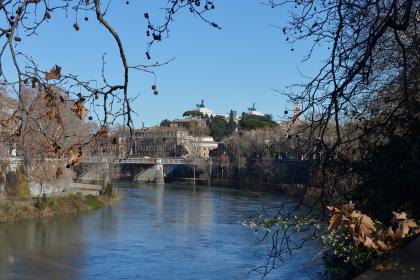
According to legend, the history of Rome begins right here
Pons Aemilius (Ponte Rotto - Broken Bridge)
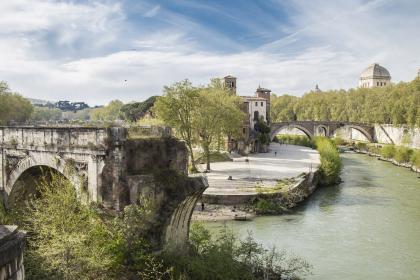
 Condividi
Condividi
The ancient mills on the Tiber
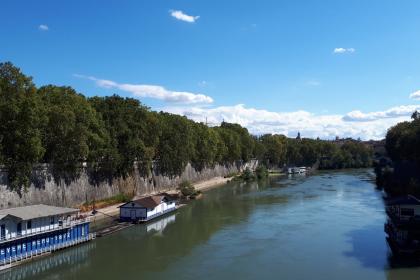
The Barcaccia Fountain
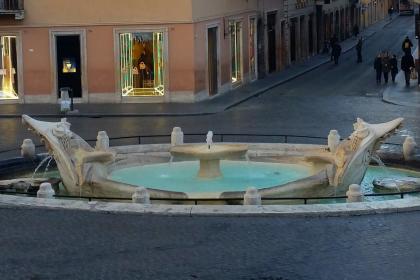
 Condividi
Condividi
The Basilica of Santa Maria sopra Minerva
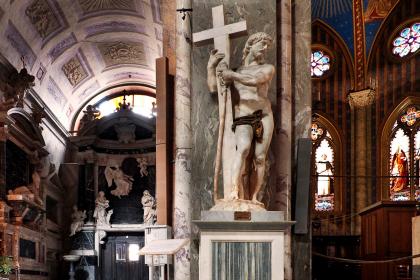
 Condividi
Condividi
